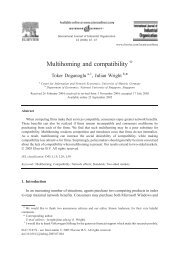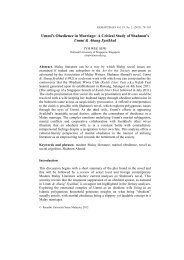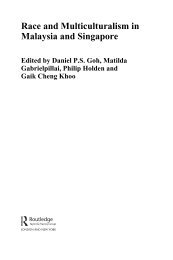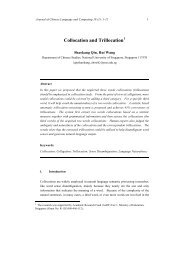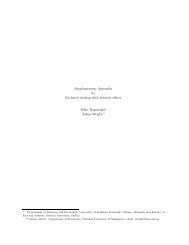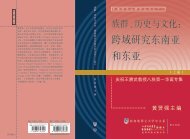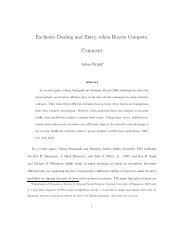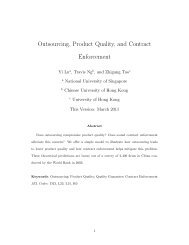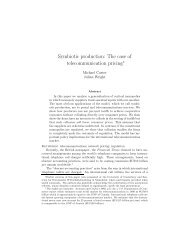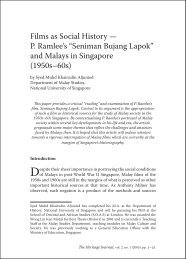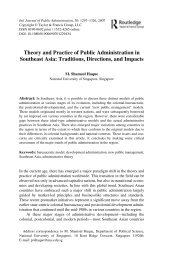Create successful ePaper yourself
Turn your PDF publications into a flip-book with our unique Google optimized e-Paper software.
Urban Studies, Vol. 39, No. 9, 1685–1701, 2002<br />
Kampung Rules: Landscape and the<br />
Contested Government of Urban(e) <strong>Malayness</strong><br />
Tim Bunnell<br />
[Paper rst received, December 2001; in nal form, February 2002]<br />
Summary. Kampung (‘village’) habits and traits have been widely invoked in ‘explanations’ of<br />
inappropriate urban conduct among Malays in Malaysia. State-sponsored rural–urban migration<br />
for Malays from the 1970s was bound up with a conception of urbanisation as a remedy for the<br />
supposedly socioeconomically debilitating effects of kampung life. Yet many such migrants,<br />
especially in the national capital, Kuala Lumpur, came to live in squatter kampungs. A dominant<br />
Malay nationalist rationality of government has long understood squatter settlements as a failure<br />
of attempts to urbanise the Malay. Even when squatters are relocated to public ats, ‘kampung<br />
values’ have been invoked to account for inappropriate social conduct. However, kampung norms<br />
and forms are increasingly drawn upon in authoritative conceptions of Malay and even<br />
Malaysian urbanity. ‘Kampung rules’ for Kuala Lumpur’s physical and moral landscape are<br />
shown to emerge from the contested government of urban(e) <strong>Malayness</strong>.<br />
1. Introduction<br />
In May 1997, a 27-year-old technical assistant<br />
was killed by a brick thrown from block<br />
94 of the Putra Ria apartments on Jalan<br />
Bangsar, Kuala Lumpur. The front cover of<br />
the English language daily Malay Mail on 30<br />
May featured this ‘murder’ and called for an<br />
awareness campaign to ‘educate’ atdwellers<br />
on appropriate means of garbage<br />
disposal (Malay Mail, 1997a). 1 Around 100<br />
of the low–medium cost ats are occupied by<br />
former residents of the adjacent Kampung<br />
Haji Abdullah Hukom squatter settlement<br />
and they are concentrated in block 94 (see<br />
Figure 1). 2 The incident was interpreted in<br />
both the Malay- and English-language press<br />
in terms of the maladaptation of former<br />
squatters to life in modern high-rise blocks:<br />
on 31 May, another front-page report included<br />
the sub-heading, ‘kampung habits die<br />
hard’ and noted that<br />
although it has been nearly a year since<br />
they were relocated from Kampung Abdullah<br />
Hukom to the new ats, the residents<br />
never really discarded their habit of<br />
indiscriminate rubbish dumping (Malay<br />
Mail, 1997b).<br />
Kampung (‘village’) habits and traits have<br />
been widely invoked in ‘explanations’ of<br />
inappropriate urban conduct among Malays<br />
in Malaysia. State-sponsored rural–urban migration<br />
for Malays from the 1970s was<br />
Tim Bunnell is in the Department of Geography, National University of Singapore, 1 Arts Link, Kent Ridge, Singapore 117570.<br />
Fax: (65) 777 3091 E-mail: geotgb@nus.edu.sg . The author is grateful for comments on earlier drafts of this paper from three<br />
anonymous referees, Deborah Martin and, in particular, Goh Beng Lan who acted as discussant at the workshop at the National<br />
University of Singapore where it was presented in June 2001. The author has not been able to meet all the suggestionsfrom her thorough<br />
review. The cartographi c work of Lee Li Kheng is also gratefully acknowledged .<br />
0042-0980 Print/1360-063X On-line/02/091685-17 Ó 2002 The Editors of Urban Studies<br />
DOI: 10.1080/0042098022015172 7
1686<br />
TIM BUNNELL<br />
Figure 1. Putra Ria Flats, block 94 (author’s photograph).<br />
founded on a conception of urbanisation as a<br />
remedy for the supposedly socioeconomically<br />
debilitating effects of kampung life. Yet<br />
many such migrants, especially in and<br />
around the national capital, Kuala Lumpur,<br />
came to live in squatter kampungs. The nomenclature<br />
is signi cant: for city authorities,<br />
‘kampung’ signi es anti-urbanity. The very<br />
continued existence of the squatter settlement<br />
represents the failure of state attempts to<br />
urbanise the Malay and is an eyesore on<br />
Kuala Lumpur’s globally oriented cityscape.<br />
In addition, as press coverage of the block 94<br />
incident demonstrates, squatters who have<br />
been relocated to modern public ats are said<br />
to have taken their ‘kampung values’ with<br />
them. Kampung has long been more than<br />
merely an undesirable space in, or feature of,<br />
the Malaysian urban landscape; it denotes<br />
those attributes, attitudes and modes of conduct<br />
deemed unsuitable for urban(e) life and<br />
for citizens of a would-be ‘fully developed’<br />
nation. 3<br />
The aims of this paper are two-fold. First,<br />
it seeks to elaborate the government of<br />
Malay subjects in relation to a problematics<br />
of kampung. I draw upon the burgeoning<br />
governmentality literature (Foucault, 1991;<br />
see Dean, 1999; and Rose, 1999, for recent<br />
overviews) to analyse attempts to (re)shape<br />
individual and collective Malay conduct.<br />
Successive governmental strategies, from the<br />
state promotion of Malay rural–urban migration<br />
to the construction of low-cost public<br />
ats for the rehousing of squatter settlements,<br />
have impacted upon the landscape of the<br />
federal capital. This leads on to a second aim<br />
which concerns combining insights from<br />
‘governmentality’ with work on landscape in<br />
cultural geography. If landscape, for cultural<br />
geographers, has been understood as both a<br />
‘work’ and as something that ‘does work’<br />
(Mitchell, 2000, p. 94), this does not of<br />
course imply a simple reversion to environmental<br />
determinism. Rather, David Matless<br />
(1994, p. 129), for example, has considered<br />
environmental ‘practices of the self’: how<br />
individuals sustain and remake themselves<br />
through their environment, which they in<br />
turn recon gure. 4 A process of landscape(d)
KAMPUNG RULES 1687<br />
subjecti cation implies the existence of ‘cultural<br />
authorities’—a term extending beyond<br />
‘the state’ and other conventional conceptions<br />
of political power—which shape conceptions<br />
of appropriate land use, ‘moral<br />
geographies’ (Matless, 1998). In this way,<br />
landscape is understood normatively: the<br />
way in which ideas about what is right and<br />
appropriate are ‘transmitted through space<br />
and place’ (Cresswell, 1996, p. 8).<br />
The persistence of city kampungs and putatively<br />
‘kampung conduct’ reveals both the<br />
limits and the limitations of the authoritative<br />
urban(e) code in contemporary Kuala<br />
Lumpur. On the one hand, it is precisely<br />
those spaces and social practices deemed<br />
‘out of place’ that make known the<br />
boundaries of what is acceptable. Trangression<br />
is thus ‘diagnostic’ of the normative<br />
landscape (see Cresswell, 2000). On the<br />
other hand, the very fact of individual and<br />
collective transgressive acts attests to the<br />
limits of the effectiveness of the normalising<br />
governmental power of landscape. While<br />
governmentality is characterised by a belief<br />
that ever-new strategies, techniques and technologies<br />
can ameliorate society and set problematic<br />
conduct in desired directions,<br />
government is a “congenitally failing operation”<br />
(Miller and Rose, 1990, p. 18). As an<br />
“applied art” (Dean, 1994, p. 187), government<br />
is also inevitably bound up with contest<br />
and competition among individuals and<br />
groups. The governmentality literature highlights<br />
ways in which on-going contestation<br />
(re)constitutes rationalities through which<br />
(self-)government takes place. The on-going<br />
failure and problematisation of practices of<br />
government, in other words, gives rise to a<br />
reworking of rationality which is itself a<br />
source of future political inventiveness<br />
(Dean, 1994). In sum: “our present has arisen<br />
as much from the logics of contestation as<br />
from any imperatives of control” (Rose,<br />
1999, p. 277). This includes the landscape,<br />
shaped by and shaping contestation.<br />
This paper considers how ‘contested landscapes’<br />
might be reconceptualised in terms<br />
of an analytics of government. It is divided<br />
into three main sections. The next section<br />
sketches the emergence of a discursive formation<br />
in which it became possible to visualise<br />
and to know ‘the Malay’ (and<br />
‘<strong>Malayness</strong>’) as a coherent object/subject to<br />
be governed and as one in need of new forms<br />
of government. In particular, section 2 considers<br />
how, within a politically dominant<br />
Malay nationalist rationality of government,<br />
kampung came to denote a ‘problematics of<br />
<strong>Malayness</strong>’. This rationalised successive<br />
governmental strategies oriented towards the<br />
‘urbanisation’ of <strong>Malayness</strong>. The third section<br />
then considers the translation of this<br />
rationality into the contested landscape of<br />
contemporary Kuala Lumpur and to Kampung<br />
Haji Abdullah Hukom—Putra Ria in<br />
particular. Not only is kampung ‘out of<br />
place’ in an increasingly image-conscious,<br />
globally oriented national capital, but supposedly<br />
‘kampung acts’ transgress authoritative<br />
conceptions of appropriate city conduct.<br />
In revealing ‘urban(e) limits’, kampung thus<br />
also brings into view the hegemonic moral<br />
order and ‘appropriate’ relations for individuals<br />
with their environment and with each<br />
other. The fourth section then takes a closer<br />
look at the contested emergence of a normative<br />
urban landscape. Somewhat paradoxically,<br />
‘kampung’ is increasingly prominent in<br />
the norms and forms of urban(e) development<br />
in Malaysia. This points to the inadequacy<br />
of conceptions of kampung as<br />
everyday ‘resistance’ to a hegemonic developmentalist<br />
rationality of government (see<br />
Chua, 1995). The paper concludes by considering<br />
the broader signi cance of this form of<br />
analysis for the meaning of ‘contest’ in a<br />
rapidly changing Asian city landscape as<br />
well as the implications of emerging ‘kampung<br />
rules’ for Kuala Lumpur’s urban population,<br />
especially its poorer members.<br />
2. Kampung as Problematic of <strong>Malayness</strong><br />
How did the Malay(s) become known as an<br />
object and subject of government ‘<strong>Malayness</strong>’<br />
as a political category is a colonial<br />
construction. ‘Malay’ was one of three broad<br />
ethnic categories—the other two being ‘Chinese’<br />
and ‘Indian’—cemented through the
1688<br />
TIM BUNNELL<br />
nature of British colonial economic development<br />
and the evolving labour market. The<br />
colonial economy also promoted a spatial<br />
divide which mutually reinforced ethnic or<br />
racial distinctions. For the most part, Malays<br />
lived in rural kampungs (‘villages’); Indians<br />
worked on the British plantation estates; and<br />
the Chinese on smaller plantations and in the<br />
mines. Given that a number of tin mining<br />
areas, including parts of what is now Kuala<br />
Lumpur, subsequently became nodes for urban<br />
development, this colonial division later<br />
manifested itself as one of a generalised Chinese<br />
urban, versus Malay and Indian rural,<br />
inhabitation (Sioh, 1998).<br />
The post-independence Alliance government<br />
not only inherited colonial constructions<br />
of ethnic groups or communities as<br />
knowable entities, but also shared the colonial<br />
administration’s prejudices against—<br />
and conception of appropriate means of<br />
ruling—the Malays. For the aristocratic,<br />
British-educated rst Prime Minister of<br />
Malaysia, Tungku Abdul Rahman, rural<br />
Malays were poor, but nonetheless happy<br />
and contented. Development, he argued,<br />
might actually make the rural poor disgruntled:<br />
“My experience tells me that everybody<br />
wants to continue to live the life they<br />
have been living” (quoted in Sardar, 2000,<br />
p. 163). Laissez-faire policies more<br />
broadly—particularly in the economic domain—played<br />
into the hands of British capitalist<br />
interests. Limited domestic participation<br />
in the national economy continued to<br />
be predominantly ‘non-Malay’, and especially<br />
Chinese. Re ecting the locus of the<br />
electoral support of the United Malays National<br />
Organisation (UMNO), what interventionist<br />
state initiatives did exist focused on<br />
rural development (Gomez and Jomo, 1997).<br />
The early 1970s saw the political crystallisation<br />
of distinct new aims and means of<br />
Malay government. These certainly shared<br />
colonial and Alliance government prejudices<br />
about the Malay as ‘lazy native’ (see Alatas,<br />
1977), but also differed in (at least) two<br />
ways. First, <strong>Malayness</strong> was labelled problematic.<br />
A new generation of Malay political<br />
leaders saw in colonial characterisations of<br />
<strong>Malayness</strong> the need for reformation through<br />
governmental intervention. The political ascendancy<br />
of this Malay nationalist mode of<br />
thinking was marked by Abdul Razak’s takeover<br />
as Prime Minister and UMNO President<br />
(Shamsul, 1996) as well as by the far<br />
stronger role of UMNO in the new Barisan<br />
Nasional (‘National Front’) coalition than in<br />
the Alliance which it replaced. 5 Secondly,<br />
and relatedly, new modes of government<br />
were founded on a belief in the possibility of<br />
intervention—setting Malay conduct in desired<br />
directions. In his polemical book, The<br />
Malay Dilemma, (now Prime Minister) Dr<br />
Mahathir Mohamad combined an environmental<br />
determinist account of Malay ‘backwardness’<br />
vis-à-vis the Chinese with<br />
understandings from evolutionary biology.<br />
Thus, on the one hand,<br />
If we want to examine the development of<br />
the Malays in Malaya we must rst study<br />
the geography of Malaya and determine its<br />
effects on them (Mahathir, 1970, p. 20).<br />
On the other hand, the supposedly debilitating<br />
effects of Malay heredity and environment<br />
can be overcome by a “systematic and<br />
co-ordinated orientation of the Malays towards<br />
progress” (Mahathir, 1970, p. 113). 6 If<br />
British colonialism constructed ‘<strong>Malayness</strong>’,<br />
then increasingly powerful Malay nationalist<br />
political thought rendered it in need of rehabilitation.<br />
‘Kampung’ featured prominently in this<br />
problematics of <strong>Malayness</strong> and resultant new<br />
governmental prescriptions. In The Malay<br />
Dilemma, the Malay kampung (‘village’) is<br />
singled out as the locus for ‘primitive’ social<br />
practices and values: ‘Malay partiality towards<br />
inbreeding’ (Mahathir, 1970) in the<br />
kampungs is contrasted not only with the<br />
Chinese—whose ‘custom decreed that marriage<br />
should not be within the same clan’<br />
(Mahathir, 1970)—but also with ‘town<br />
Malays’ who intermarried with Indian Muslims<br />
and Arabs. Related to this is a spatial<br />
dimension to Mahathir’s understanding of<br />
Malay “exclusion from the commercial life<br />
of the country” (Mahathir, 1970, p. 37). Noting<br />
the “importance of urbanization in the
KAMPUNG RULES 1689<br />
progress of a community” (pp. 79–80), he<br />
argues that the colonial economy condemned<br />
Malays to static, backward, rural areas.<br />
Malay ‘backwardness’, then, is, in part, interpreted<br />
as a consequence of the geography of<br />
colonial development and a planned programme<br />
of Malay urbanisation is considered<br />
crucial if the Malays are to ‘master’ modern<br />
ways<br />
The fact of urbanisation alone involves a<br />
process of physical and psychological uprooting<br />
of the Malays from the traditional<br />
rural society. There can be no doubt that<br />
with this uprooting, old values and ways<br />
of life must give way to the new (Mahathir,<br />
1970, p. 113).<br />
The urban is thus imagined as a potential<br />
incubator of modern <strong>Malayness</strong>, a remedy<br />
for pathological values of the kampung.<br />
Mahathir’s conception of the bene cial effects<br />
of urban environment and living on<br />
Malay conduct was echoed in subsequent<br />
state policy documents. The Second<br />
Malaysia Plan 1971–75 (MP2), for example,<br />
considered exposure to the “in uences of an<br />
urban environment” as necessary for the<br />
modernisation of Malays (Malaysia, 1971,<br />
p. 45). In addition to introducing modern industries<br />
to rural areas, therefore, the plan<br />
identi ed a need to develop new urban<br />
growth centres in new areas and for the<br />
migration of rural inhabitants to existing urban<br />
areas (Lee, 1987). More and more<br />
Malays did become classi ed as ‘urban’ during<br />
the MP2 period: Malays accounted for<br />
some 37.9 per cent of the total urban population<br />
by 1980 as compared with only 27.6 in<br />
1970 (Malaysia, 1983, p. 21). More than<br />
two-thirds of the rural–urban migrants during<br />
the 1970s were Malays (Mohd. Razali,<br />
1989). The Malay rural–urban ‘drift’ was<br />
partly a result of ‘push factors’ such as decreasing<br />
access to kampung land and declining<br />
smallholder productivity, but it was also,<br />
according to the Malaysian <strong>Home</strong> Affairs<br />
Minister at that time, “a deliberate … social<br />
engineering strategy” (quoted in Ong, 1987,<br />
p. 145). Government efforts included the establishment<br />
of 59 industrial estates during<br />
the 1970s, 9 of which were free trade zones<br />
(FTZs). Export-oriented manufacturing subsidiaries<br />
of foreign transnational corporations<br />
were lured to these zones on the condition<br />
that at least 40 per cent of their workforce<br />
was bumiputera (Ong, 1981). 7<br />
Rural–urban migration, however, was not<br />
necessarily synonymous with Malay urbanisation.<br />
Malay rural migrants arriving in<br />
Kuala Lumpur-Klang Valley after 1970 came<br />
to live in squatter settlements, either moving<br />
to existing squatter areas, or opening up new<br />
ones on government or privately owned land<br />
(Syed Husin, 1997). Along the Klang Valley,<br />
Malay villages on the edge of former tin<br />
mines, in particular, became cores of new<br />
squatter settlements (Brook eld et al., 1991).<br />
Terry McGee’s important work in Southeast<br />
Asia in general had long posed doubts about<br />
the conventional distinction between urban<br />
and rural (McGee, 1967). Certainly, many<br />
Malays living in and around Kuala Lumpur<br />
in the 1960s and 1970s, including those in<br />
Kampung Haji Abdullah Hukom, did not t<br />
neatly into the category of ‘urban’ (McGee,<br />
1976). Petempatan setinggan (‘squatter settlements’)<br />
are still frequently referred to simply<br />
as kampungs (‘villages’) (Mohd. Razali,<br />
1993). Azizah Kassim (1982) traces the rst<br />
of cial reference to ‘Malay squatters’ back<br />
to 1966 but notes that, by the early 1980s,<br />
squatting in Kuala Lumpur had become a<br />
predominantly ‘Malay problem’. 8 It was the<br />
city kampung or, more accurately, the squatter<br />
city kampung which came to be known as<br />
the site of a new urban problematic of<br />
<strong>Malayness</strong>.<br />
City kampungs have been rendered problematic<br />
by a diversity of ‘experts’ ranging<br />
from state policy-makers and international<br />
agencies to academics and religious authorities.<br />
The very continued use of the term<br />
‘kampung’ in the context of UMNO-centred<br />
Malay nationalism signi es failed urbanisation.<br />
Rather than contributing to the modern,<br />
urban(e) life of the nation, Malay squatters<br />
are, at best, perceived to have brought the<br />
village into the city. One academic report in<br />
the mid 1970s, for example, noted the<br />
“primitive level” of rubbish disposal at
1690<br />
TIM BUNNELL<br />
Kampung Haji Abdullah Hukom and other<br />
predominantly Malay squatter kampungs<br />
(Pirie, 1976, p. 56). What Nooi et al. (1996,<br />
p. 133) have more recently termed the “dark<br />
side” of the kampung refers to a wide range<br />
of supposedly ‘inadequate’ or ‘improper’ living<br />
conditions and issues of urban poverty.<br />
There have been various authoritative interventions<br />
to address such problems, some,<br />
such as the so-called Sang Kancil project,<br />
working through existing community organisations<br />
(Mohd. Razali, 1989, p. 78). Yet<br />
most in situ development has been related to<br />
more conventional conceptions of ‘political<br />
power’. Squatter kampungs form potentially<br />
signi cant vote-banks which have been won<br />
by the provision (or at least promise) of a<br />
range of basic amenities (Guinness, 1992;<br />
Yeoh, 2001). Such patronage also conferred<br />
some protection against eviction and demolition<br />
which were the initial focus of post-<br />
1970 urban managerial strategies. In fact, in<br />
situ governmental interventions such as Sang<br />
Kancil were responses to recognition of the<br />
dif culty of resettlement and rehousing, particularly<br />
with regard to the generation of<br />
suf cient public funds (Mohd. Razali, 1989).<br />
This policy preference has changed again as<br />
kampung has increasingly been considered<br />
‘out of place’ in the moral landscape of<br />
Malaysia’s main metropolitan centre.<br />
3. Urban(e) Limits<br />
The problematisation of kampung in the city<br />
landscape in the 1990s remained a matter of<br />
aesthetic and moral as well as of strictly<br />
economic (or political economic) calculation.<br />
Certainly, the increased urgency of squatter<br />
resettlement and the eradication of their kampungs<br />
are associated with rapid urbanisation<br />
and industrialisation in the Mahathir era<br />
(Syed Husin, 1997). Seen from the perspective<br />
of the developmentalist Malaysian state,<br />
the squatter kampung has become a ‘waste of<br />
space’ as demand for city land has risen (see<br />
Scott, 1998). However, the inadequacy of<br />
such ‘economic’ explanations may be understood<br />
in two ways. First, squatter settlements<br />
have no place in Kuala Lumpur City Hall’s<br />
idealised vision of the national capital (Kuala<br />
Lumpur City Hall, 1993) and attempts to<br />
(re)image the city and nation globally (Bunnell,<br />
1999). A second problematisation concerns<br />
undesirable social conduct. Kampung<br />
Malays’ supposed maladaptation to modern,<br />
urban life is manifested in new ‘social ills’<br />
such as dadah (‘drug abuse’) and lepak<br />
(‘loa ng’) (see Malaysia, 1996). In the authoritative<br />
imagination, therefore, squatter<br />
kampungs are sites which both signify and<br />
propagate inappropriate Malay conduct. The<br />
repeated of cial goal of making Kuala<br />
Lumpur into a ‘squatter-free’ city 9 is therefore<br />
bound up with broader governmental<br />
attempts to realise Melayu Baru (the ‘new<br />
Malay’) through appropriate urbanisation<br />
(see Muhammad, 1993). City Hall’s stated<br />
policy is, “to resettle the squatters into<br />
planned residential environment [sic] with all<br />
modern amenities and facilities” (Mokhtar,<br />
1993, p. 17).<br />
The proliferation of low-cost high-rise<br />
blocks in the Kuala Lumpur cityscape thus<br />
represents a programme of modernist regeneration<br />
which may be considered moral as<br />
much as infrastructural. The choice of highrise<br />
ats as the appropriate solution to the<br />
‘squatter problem’ in Kuala Lumpur, as elsewhere,<br />
of course, is to a large extent determined<br />
by cost (see Morshidi et al., 1999).<br />
Nonetheless, as technologies of government,<br />
these landscape artefacts are intended as<br />
means to Malay urbanity. Referring to the<br />
process of squatter ‘modernisation’, the<br />
Deputy-Director in City Hall’s Economic<br />
Planning and Social Amenity Department<br />
suggested that “slowly their [squatters’] attitudes<br />
are changed in the ats”. 10 Low-cost<br />
blocks are imagined as the residential equivalent<br />
of the high-rise of ce; architectural<br />
technologies for modern practices of living<br />
standing alongside those for modern practices<br />
of working. The tragic incident at block<br />
94, however, heightened national awareness<br />
of the ‘failure’ of high-rise apartment blocks<br />
in realising modern Malays.<br />
The completion of the three 22-storey<br />
Putra Ria apartment blocks in 1995 marked
KAMPUNG RULES 1691<br />
the culmination of a series of overlapping<br />
attempts at urban(e) regeneration in and<br />
around Kampung Haji Abdullah Hukom. In<br />
the mid 1980s, squatters from around the<br />
city, including Kampung Haji Abdullah<br />
Hukom, were resettled across the Klang<br />
River from the original settlement that dates<br />
back to the end of the Second World War<br />
(Sager, 1997). Resettlement at the site of<br />
what is now the Mid-Valley development<br />
took the form of low-cost 4-storey blocks<br />
and (supposedly temporary) rumah panjang<br />
(‘longhouses’) (see Figure 2). 11 The nine 4-<br />
storey Sri Putra blocks, along with 12 blocks<br />
of longhouses, were in turn served an eviction<br />
order in 1993 to clear the way for Mid-<br />
Valley, a joint venture between Kuala<br />
Lumpur City Hall and IGB Corporation, a<br />
property and investment holding company. 12<br />
Residents of the Sri Putra ats accounted for<br />
some 552 of the 660 units at Putra Ria; a<br />
further 8 units were allocated to squatters on<br />
the Mid-Valley site which was not part of<br />
Kampung Haji Abdullah Hukum. The remaining<br />
100 of the 660 units were purchased<br />
by squatters directly from Kampung Haji<br />
Abdullah Hukum and they are concentrated<br />
in block 94. 13 The squatter kampung borders<br />
the new ats between Jalan Bangsar and the<br />
new Light Rapid Transit (LRT) track on one<br />
side and the Klang River on the other side<br />
(see Figure 2). The river separates Putra<br />
Ria—Kampung Haji Abdullah Hukom from<br />
the Mid-Valley Megamall which opened in<br />
November 1999 (see Figure 3). A new series<br />
of access roads for ‘Asia’s largest mall’,<br />
indeed, make pedestrian access from across<br />
the river virtually impossible.<br />
Despite this spatial divide, the landscape<br />
provides few visible clues as to the contest<br />
that went into its current stage of ‘regeneration’.<br />
Eviction which was scheduled for December<br />
1995 was delayed as 111 families at<br />
the Sri Putra ats refused to move to the<br />
low–medium cost Putra Ria apartments. The<br />
label ‘low–medium’ (sederhana rendah) carried<br />
a price tag of between RM36 000 and<br />
RM41 000 depending on position and size 14<br />
as compared to RM 25 000 for low-cost ats<br />
(Ghani and Lee, 1997). This was considered<br />
too expensive for a group of residents led by<br />
Sri Putra at surau committee chairman, Ahmad<br />
Baba (New Straits Times, 1996). Contest<br />
also included an NGO ghting for<br />
squatters’ housing rights, ‘Urban Pioneers<br />
Support Committee’ (Jawatankuasa Sokongan<br />
Peneroka Bandar, JSPB). The term ‘urban<br />
pioneer’ was coined to emphasise the<br />
important historical role that these communities<br />
have played in the development of the<br />
city. 15 JSPB assists and advises squatter communities<br />
‘resisting’ eviction in the absence of<br />
‘fair’ compensation and was involved in the<br />
Kampung Haji Abdullah Hukom area from<br />
the early 1990s. 16<br />
Resistance to resettlement at Sri Putra resulted<br />
in the City Hall cutting off water<br />
supplies on 15 April 1996. The water supply<br />
was reportedly restored after residents visited<br />
the mosque where the Lord Mayor attends<br />
prayers on Fridays complaining that they<br />
were unable to perform prayers themselves<br />
in the absence of water for ritual ablutions. 17<br />
However, on 2 August, some 300 City Hall<br />
personnel backed by two truck-loads of the<br />
Federal Reserve Unit arrived at the scene to<br />
evict the residents. Forceful eviction on this<br />
occasion was only prevented by the intervention<br />
of local Member of Parliament,<br />
Shahrizat Abdul Jalil. Of the 111 families,<br />
109 agreed to move that evening, while 2<br />
refused saying that they could not afford the<br />
offer. Demolition began on 6 August after<br />
the remaining 2 families agreed to move to<br />
Putra Ria (Singh, 1996).<br />
The incident at Putra Ria ats on 31 May<br />
1997 is of course to be distinguished from<br />
the opposition of former squatters to eviction<br />
and resettlement. This mortal transgression is<br />
not so much ‘resistance’ to an authoritative<br />
regime as diagnostic of broader aims and<br />
means of government of a contested moral<br />
order. On the one hand, the incident was<br />
readily narrated in terms of an existing discourse<br />
of undesirable kampung conduct in<br />
the Malaysian urban landscape—‘inappropriate’<br />
garbage disposal, ‘backward’ values,<br />
‘apathetic’ attitudes and ‘immoral’ conduct.<br />
On the other hand, the tragic consequences<br />
have elevated Putra Ria to a symbolic cen-
1692<br />
TIM BUNNELL<br />
Figure 2. Kampung Haji Abdullah Hukom and surrounding areas.<br />
trality in authoritative evaluation of city conduct.<br />
The ‘killer litter’ incident was the<br />
de ning transgression of urban(e) limits in<br />
the city. Thus, when Prime Minister Mahathir<br />
angrily rebuked Malaysians who had<br />
‘turned Jalan Bukit Bintang into a dump’<br />
some three months later, the ‘high-rise littering’<br />
at Putra Ria was speci cally mentioned
KAMPUNG RULES 1693<br />
Figure 3. The construction of Mid-Valley Megamall (author’s photograph).<br />
alongside other supposed symptoms of ‘slow<br />
social development’: horri c public toilets,<br />
illegal dumpsites, vandalism of public utilities<br />
and river pollution (Amry, 1997a). The<br />
following month it was con rmed: in terms<br />
of vandalism and high-rise littering incidents,<br />
the Putra Ria ats were ‘the worst’ in the city<br />
(New Straits Times, 1997a).<br />
Diverse explanations of problematic highrise<br />
conduct form part of the on-going contested<br />
elaboration of appropriate aims and<br />
means of government. On the one hand, for<br />
city of cials, the problem was precisely the<br />
lack of discipline and civic consciousness<br />
among inhabitants of low- and low–mediumcost<br />
dwellings. Acknowledging the failure<br />
of high-rise ats as technologies of Malay<br />
modernisation, the Deputy-Director of City<br />
Hall’s Planning and Social Amenity Department<br />
complained of “problems caused by<br />
undisciplined people who still live like<br />
they did in the kampungs”. 18 Yet this ‘kampung<br />
values’ explanation of the block 94<br />
incident runs against previous reports on<br />
Putra Ria in the state-owned press. Only six<br />
weeks earlier, for example, the New Straits<br />
Times had featured the ‘plight’ of squatters<br />
relocating from Kampung Haji Abdullah<br />
Hukum to Putra Ria (Hisham, 1997). This<br />
noted not only the crippling price of the<br />
‘low–medium’ cost ats for poor squatter<br />
families, but also the ats’ inadequate ‘pigeon<br />
hole’ size, the lack of recreational space<br />
for children and the more general poor state<br />
of repair of the buildings. One resident is<br />
cited as saying<br />
The place is in a sorry state. There are no<br />
rubbish chutes and those living on the 22<br />
oor have to come all the way down and<br />
go up again, and when the lifts are jammed<br />
it’s such a problem. And the lifts are always<br />
jammed. Then you get people throwing<br />
their rubbish from the top oor and<br />
you see cars with their windscreens<br />
smashed. You see rubbish strewn all over
1694<br />
TIM BUNNELL<br />
and we have to pay maintenance costs<br />
(quoted in Hisham, 1997).<br />
Urban pioneer NGOs also point to inadequate<br />
conditions in the public housing estates.<br />
As Syed Husin Ali, JSPB adviser, puts<br />
it, such housing usually consists of<br />
two or two and a half room ats in high<br />
rise buildings between 18 and 22 stories,<br />
and built close to one another with poor<br />
workmanship. More often than not there is<br />
no playground for children. Garbage collection<br />
is irregular and inef cient and soon<br />
the environment becomes polluted. These<br />
low cost housing areas also turn into a new<br />
slum (Syed Husin, 1998, p. 97).<br />
Contest here cannot be adequately framed in<br />
terms of a dichotomous opposition counterposing<br />
state authorities and their critics.<br />
Rather, a range of authorities including local<br />
religious leaders, MPs and NGOs are actors<br />
entangled in the contested elaboration of land<br />
(ab)use as well as means to its regeneration.<br />
It is possible to trace previous and proposed<br />
governmental modi cations to induce<br />
public- at dwellers to dispense with their<br />
‘kampung ways’. On the one hand, the ats<br />
currently being built in Kuala Lumpur are a<br />
‘third-generation’ design. 19 On-going amendments<br />
to City Hall government housing<br />
estate and building design re ect a governmental<br />
faith that future conduct can be nely<br />
tuned in desired directions through modern<br />
architecture and planning as technologies<br />
of government. On the other hand, a range of<br />
suggestions for new modes and methods of<br />
government in the city emerged from press<br />
coverage of the event at block 94. In addition<br />
to a more stringent enforcement of existing<br />
regulations—one tenant was evicted for<br />
throwing a bicycle from the Sri Sabah ats in<br />
Jalan Cheras (The Star, Metro, 1997a) and<br />
there were numerous threats of court action<br />
against tenants who failed to pay maintenance<br />
arrears for the repair of vandalised<br />
public utilities (New Straits Times, 1997b)—<br />
new surveillance technologies of (self-) regulation<br />
were introduced. This included the<br />
installation of closed circuit television<br />
at four ats to prevent vandalism (The<br />
Star, Metro, 1997b) and even ‘binocular<br />
surveillance’ of errant tenants (Malay Mail,<br />
1997c) by City Hall! Finally, there were calls<br />
for more ‘liberal’ measures to induce<br />
appropriate conduct in residents. The father<br />
of the block 94 victim, for example, is reported<br />
as advocating “educational programmes<br />
… particularly for squatters or new<br />
occupants of high-rise before they are relocated”<br />
so that they can “adapt to the new<br />
surroundings” (Malay Mail, 1997d). This last<br />
example is crucial: Malay subjects are shown<br />
to have interiorised the rationality that constructs<br />
them as in need of new forms of<br />
(self-)government on account of their ‘kampung<br />
ways’. ‘Kampung folk’ seek to conduct<br />
themselves within urban(e) limits.<br />
4. Kampung Rules<br />
Not everyone, of course, imagines kampung<br />
as synonymous with Malay anti-citizenship<br />
against which urbanity is de ned. Urban<br />
pioneer organisations valorise squatter housing<br />
and community in opposition to the ‘pigeon<br />
holes’ and ‘arti cial society’ of public<br />
housing. 20 JSPB volunteers point to the fact<br />
that in the kampung—even in the squatter<br />
kampung—houses may be built and rebuilt<br />
according to speci c and changing needs.<br />
Kampung housing is thus understood literally<br />
to accommodate culture, allowing it to develop<br />
and ourish. High-rise ats, in contrast,<br />
are said to consist of an inappropriate,<br />
standardised design imposed ‘from above’.<br />
This provides inadequate public space for<br />
cultural festivities essential for community<br />
well-being. Kampung community, indeed, is<br />
said to be dismantled once its members are<br />
‘put away’ in the ats. Connotations of criminality<br />
are more than coincidental here; 21 the<br />
lived consequences are said to be<br />
con nement, isolation. Finally, urban pioneers<br />
no longer enjoy the fruits (and vegetables)<br />
of the land that they have ‘greened’ and<br />
‘improved’ once they are resettled. Kampung<br />
here, then, denotes not modes of conduct to<br />
be overruled by self-discipline and/or edu-
KAMPUNG RULES 1695<br />
cation, but a rationalised preference over<br />
‘pigeonholing’ in modern ats.<br />
However, I suggest that the seductive simplicity<br />
of labelling these kampung imaginings<br />
as ‘resistance’ in opposition to a<br />
developmentalist authoritative rationality<br />
oversimpli es the contested government of<br />
urban <strong>Malayness</strong>. Any such dichotomy is<br />
clearly untenable given the valorisation of<br />
kampung in a range of contemporary urban<br />
development projects, from private-sector<br />
condominiums to state-sponsored ‘intelligent<br />
cities’ under construction in Malaysia’s Multimedia<br />
Super Corridor (see Bunnell, forthcoming).<br />
Kampung, in fact, has long<br />
symbolised the seat of traditional <strong>Malayness</strong>,<br />
a retreat or haven from processes of capitalist<br />
modernity. This was mobilised in the 1970s,<br />
for example, by the Islamic dakwah movement<br />
which called for a reaf rmation of kampung<br />
morality (see Kessler, 1980). The<br />
contemporary urban (re)valorisation of kampung,<br />
however, is rather different. Its concern<br />
is not with ‘traditional’ opposition or<br />
resistance to Malay modernisation, but with<br />
kampung as a resource for the contested reworking<br />
of the prevailing dominant rationality<br />
of government. ‘Kampung’, in other<br />
words, signals not the failure of governmental<br />
strategies for Malay urbanity, but a<br />
series of codes for modernity articulated in<br />
Malay and even Malaysian terms. Kampung<br />
rules de ne norms and forms of Malay(sian)<br />
modernity.<br />
These aims and means of development<br />
emerge, in part, as a result of what might be<br />
understood as the ‘identity problem’ of<br />
Malaysia’s modernising urban landscape.<br />
Identity ‘loss’ is perhaps most frequently<br />
lamented in relation to the modern buildings<br />
in which an increasing proportion of Malays<br />
live and work and which together constitute a<br />
‘placeless’ urban milieu. This lamentation<br />
has, in fact, been prevalent since the early<br />
1980s during which time it prompted a<br />
search for Malay-centred national identity in<br />
Malaysian architecture and urban design<br />
(Ngiom and Tay, 2000). A common response<br />
has been the incorporation of putatively<br />
‘local’ motifs into modern buildings. ‘Kampung-style’<br />
has featured prominently in landscaped<br />
national identity-building as<br />
evidenced from the entrance to Hijjas Kasturi’s<br />
Maybank Headquarters in Kuala<br />
Lumpur. Kampung symbolism has been<br />
widely employed in both the new Federal<br />
Government Administrative centre, Putrajaya,<br />
and the recently opened Kuala Lumpur<br />
International Airport (KLIA) (on the latter,<br />
see Kurokawa, 1999) (see Figure 2). As regionalist<br />
architects have suggested, however,<br />
buildings with kampung references ‘tacked<br />
on’ function no differently from their modernist<br />
international-style denominators (see<br />
Yeang, 1989). Certainly, the government of<br />
landscape cannot be reduced to the imagination<br />
or construction of a recognisable urban<br />
form. Kampung is also bound up with the<br />
(re)de nition and promotion of appropriate<br />
urban conduct among modern Malays.<br />
Perhaps the most prominent invocation of<br />
kampung rules for Malay urban(e) conduct<br />
concerns the fostering or rekindling of neighbourly<br />
interaction and a sense of ‘community’.<br />
The convenient English translation<br />
of the word kampung as ‘village’—denoting<br />
a physical or administrative area—arguably<br />
misses a sense of the word as a set of relations<br />
between people, a community (Shamsul,<br />
1988). Of cial texts on Malaysia’s new<br />
electronic federal government administrative<br />
centre, Putrajaya, borrow (at least rhetorically)<br />
from ‘kampung’ ideas of social organisation.<br />
One describes how so-called<br />
neighbourhood units are “designed to promote<br />
increased social contacts and neighbourly<br />
interactions which sadly is rapidly<br />
eroding in our pursuit of material progress”<br />
(Azizan, 1997, p. 3). The intended result is<br />
“a community way of life that encourages<br />
high moral values” (Amry, 1997b). Kampung<br />
is thus valorised in relation to morally problematic<br />
Malaysian city life characterised by a<br />
lack of civic consciousness and community<br />
spirit. An article in the UMNO-controlled<br />
New Straits Times, following the reported<br />
prompting of suggestions by Prime Minister<br />
Mahathir, called for “Malaysians migrating<br />
from kampungs to urban areas to practice<br />
their culture and lifestyle in their new sur-
1696<br />
TIM BUNNELL<br />
roundings” (Shukor Rahman, 1996, p. 8).<br />
Mahathir, the archetypal proponent of Malay<br />
modernisation through urbanisation, is credited<br />
with the following characterisation: “The<br />
kampung lifestyle is founded on mutual help<br />
whereas in the urban areas even immediate<br />
neighbours do not know each other” (quoted<br />
in Shukor Rahman, 1996). The same article<br />
thus suggested that it was “essential that<br />
kampung traits like neighbourliness, co-operation,<br />
willingness to help, gotong-royong and<br />
courtesy be cultivated in city living” (Shukor<br />
Rahman, 1996). Gotong-royong (‘shared<br />
labour’ or voluntary mutual assistance), in<br />
particular, is exalted as exempli ng collective<br />
kampung conduct—appropriate ways of<br />
dealing with one another and with ‘others’—<br />
informing appropriate <strong>Malayness</strong> in the urban<br />
context.<br />
The government of landscape here extends<br />
beyond the (re)shaping of city sites and<br />
spaces to foster kampung social interaction.<br />
Rather, the moral geography of kampung<br />
rules is also bound up with de nitions of<br />
appropriate uses of, and interrelations with,<br />
the urban environment. In the debate following<br />
the ‘shame’ of Jalan Bukit Bintang, one<br />
article contrasted the ‘culture of rubbish’ in<br />
the city where public places are considered to<br />
‘belong to nobody’ with the cleanliness of<br />
the village with its strong sense of collective<br />
ownership (Nelson, 1997). Sociologist Norani<br />
Othman is cited as prescribing kampung<br />
as a model of collective environmental responsibility<br />
to be translated to the urban<br />
context. While the imagined village referent<br />
here is clearly not the urban kampung setinggan,<br />
even the latter has instructive human–<br />
environmental relations. In his<br />
‘kampungminium’ project in Rawang, north<br />
of Kuala Lumpur, the architect Jimmy Lim<br />
ensured that all residents would be allocated<br />
a plot enabling them to ‘bond with the environment’<br />
22 and thus enjoy what urban pioneers’<br />
groups referred to as the ‘subsidy of<br />
the land’. 23 Of course, often such kampung<br />
reconnections are either marketing gimmicks<br />
or else, as Norani points out, ‘done to impress<br />
some politician’. Yet these practices<br />
and critique of them, I suggest, form part of<br />
the contested emergence and reshaping of the<br />
rules of kampung government.<br />
The nostalgic marketing of kampung<br />
should not obscure the fact that kampung<br />
rules are oriented towards the de nition and<br />
realisation of Malaysian modernity (see also<br />
Kahn, 1992). Three issues exemplify how the<br />
kampung is harnessed to modern urban(e)<br />
development goals. First is a goal of urban<br />
sustainability. The design rationale for<br />
Malaysia’s new technopole (or ‘intelligent’<br />
city), Cyberjaya (see Figure 2), cites the<br />
kampung as an example of a<br />
landscape in which human settlement<br />
maintains a sustainable level of development,<br />
in balance with the natural environment.<br />
Resource use does not exceed the<br />
regenerative powers of the land (Federal<br />
Department of Town and Country Planning,<br />
1997, p. 46; see also Bunnell, forthcoming).<br />
Similarly, Lim Jee Yuan’s popular The<br />
Malay House: Rediscovering Malaysia’s Indigenous<br />
Shelter System describes kampung<br />
housing as being “designed with a deep<br />
understanding and respect for nature” (Lim,<br />
1987, p. 143)—a “design-with-nature approach”<br />
(Lim, 1987, p. 68). Second, is an<br />
imperative of investible city visibility. In addition<br />
to the incorporation of kampung design<br />
features into prominent buildings on the<br />
city skyline, kampung is invoked as the<br />
model for civic responsibility and, with it, a<br />
sanitised global image. Thirdly, as Patricia<br />
Sloane’s work has shown, for many corporate<br />
Malays, “Being Kampung” de nes a<br />
“modern Malay identity” (1999, p. 89).<br />
While the kampung encompassed no past<br />
economic behaviours that could be utilized<br />
in the present, and Malay feudal society<br />
had no social behaviours applicable to<br />
modern life, the kampung, now exalted as<br />
a kind of idyllic community, has, to my<br />
informants and their political leaders, instructive<br />
power in conducting modern relationships<br />
(Sloane, 1999, p. 89).<br />
Kampung here is seen as having less to do<br />
with Sloane’s informants’ past experiences
KAMPUNG RULES 1697<br />
than with a crucial de nition of their modern,<br />
urban(e) identity. If urbanisation has long<br />
been considered necessary to overcome kampung<br />
mentality, a new urban generation<br />
looks to the kampung as inspiration for conduct<br />
be tting Malay(sian) modernity.<br />
The use of parentheses here, nally, demands<br />
further explanation. On the one hand,<br />
as Sloane’s work suggests, kampung continues<br />
to inform a speci cally Malay system of<br />
urban(e) conduct. On the other hand, political<br />
changes in Malaysia have arguably<br />
served to recon gure relations between<br />
‘Malaysian’ and ‘Malay’ in state versions of<br />
the nation (Khoo, 1995). While the Malay<br />
‘special political position’ has been founded<br />
upon the Malay bangsa (or ‘ethnic’) as the<br />
‘rightful inhabitants’ of Malaysia, Mahathir’s<br />
‘Vision 2020’, announced in 1991, envisaged<br />
‘Bangsa Malaysia’ (Mahathir, 1993). The<br />
long-term signi cance of the current ‘multicultural<br />
rescripting’ of Malaysian national<br />
identity is a moot point (Bunnell, 2002a).<br />
However, the very fact that ethnic Chinese<br />
professionals alluded to above are among<br />
those authorities seeking to incorporate kampung<br />
into contemporary urban development<br />
is perhaps signi cant. It suggests not only a<br />
role for non-Malays in the (re)de nition of<br />
aims and means of ‘national’ development,<br />
but also that kampung is potentially central to<br />
such trans-ethnic reworking. Certainly, kampung<br />
here no longer signi es “an unadulterated<br />
haven against non-Malay worlds” (see<br />
Ong, 1987, p. 57). Kampung increasingly<br />
comes to inform Malaysian, as opposed to<br />
exclusively Malay, national rules of urban(e)<br />
land use.<br />
5. Conclusion<br />
I have examined ‘kampung’ in terms of the<br />
contested government of urban(e) <strong>Malayness</strong>.<br />
Kampung is understood as both a<br />
physical space in the Malaysian urban landscape<br />
and a code for how (not) to conduct<br />
oneself appropriately in the city. Two versions<br />
of kampung are shown to co-exist in<br />
the moral geography of contemporary Kuala<br />
Lumpur. In the rst, kampung denotes sites<br />
and conduct rendered ‘out of place’ in the<br />
city, transgressing and thereby revealing<br />
authoritative urban(e) limits. In the second,<br />
kampung informs emerging norms and forms<br />
of Malay, and increasingly Malaysian,<br />
modernity. ‘Kampung rules’ of landscaped<br />
urban Malay(sian)ness may thus be considered<br />
as an increasingly powerful system<br />
of evaluation in opposition to a developmentalist<br />
rationality of government (see Murdoch,<br />
2000) which has long rendered<br />
kampung problematic.<br />
However, analysis at the level of rationalities<br />
of government unsettles existing conceptualisations<br />
of power and contest in urban<br />
landscapes (see, for example, Chua, 1995;<br />
Ockey, 1997). Writing on Singapore, Chua<br />
Beng Huat (1995) has noted the potential for<br />
nostalgic everyday imaginings of kampung—<br />
spaces which have largely disappeared from<br />
the ‘real’ landscape of the city-state—to constitute<br />
‘resistance’ against a modernising,<br />
materialistic present. Such imaginings, according<br />
to Chua, are in turn countered by an<br />
all-powerful development-oriented state.<br />
This binary analytical distinction between the<br />
state and its opponents is clearly inadequate<br />
in Malaysia and, I would argue, elsewhere<br />
too. First, work on governmentality has unsettled<br />
taken-for-granted notions of the unity<br />
and coherence of state power (Foucault,<br />
1991). Even to the extent that the state can be<br />
recognised as a uni ed actor, in Malaysia at<br />
least, it is one which participates in cultural<br />
valorisation of kampung as well as its problematisation.<br />
Yet, more fundamentally,<br />
‘government’ in Malaysia (and even in Singapore)<br />
is the work of a range of authorities<br />
including the state (see Rose, 1999). In the<br />
contested landscape of contemporary Kuala<br />
Lumpur, as we have seen, this includes architects,<br />
planners, sociologists, NGOs, city<br />
government of cials, planners and property<br />
developers, some of whom are politically<br />
opposed to the Barisan Nasional government.<br />
Secondly, it is misleading to see these<br />
authorities as constitutive of ‘power’ acting<br />
upon and/or resisted by everyday individuals<br />
and groups. I have charted the contested<br />
(re)construction of appropriate urbanity and
1698<br />
TIM BUNNELL<br />
means to achieving it. The failure of programmes<br />
and strategies gives rise to an ongoing<br />
reworking of aims and means of<br />
government. In this way, a multiplicity of<br />
actors, from errant resettled squatters to the<br />
Lord Mayor, are bound up in the refashioning<br />
of Kuala Lumpur’s normative landscape.<br />
This reworking of ‘contest’ is not, nally,<br />
to dismiss urban inequalities relating to an<br />
emergent Malay(sian) rationality of ‘kampung<br />
rules’. On the one hand, the kampung<br />
imaginings of resettled squatters and their<br />
advocators appear to be echoed in new ideals<br />
and objectives of architects, urban planners<br />
and even political authorities. On the other<br />
hand, we might ask to what extent the valorisation<br />
of kampung translates into tangible<br />
bene ts for the urban poor, of whatever ascribed<br />
ethnicity. The exclusive ‘kampungminium’<br />
(Real Estate Review, 1993), the<br />
would-be ‘multimedia utopias’ of Malaysia’s<br />
new ‘intelligent cities’ (Bunnell, 2002b),<br />
even ‘being kampung’ (Sloane, 1999), all<br />
imply new social landscapes of division and<br />
exclusion. Kampung rules are thus bound up<br />
with social and spatial ‘dividing practices’<br />
(see Rose, 1996) centred upon individual<br />
and collective (in)abilities of urban(e) selfrealisation.<br />
In this highly inequitable, contested<br />
moral geography, it is no surprise that<br />
a rationality of government valorising kampung<br />
is rising to prominence while the kampung<br />
setinggan disappears from the city<br />
landscape at an accelerated rate.<br />
Notes<br />
1. The Malay-language Utusan Malaysia<br />
(1997) also carried the story, although only<br />
on page 3.<br />
2. Personal communication with Of cer, Department<br />
of Housing Management, Kuala<br />
Lumpur City Hall, 8 September 1997.<br />
3. This is the national development, ‘Vision<br />
2020’ (Mahathir, 1993).<br />
4. The notion of the agency of individuals in<br />
(re)making themselves here is crucial. Critical<br />
arguments against Michel Foucault’s radical<br />
decentring of ‘the subject’ are well<br />
rehearsed, but it was precisely through the<br />
concept of governmentality that he sought to<br />
overcome these in his later work (McNay,<br />
1994). The theme of governmental power is<br />
to be distinguished from earlier concerns<br />
with the formation of domains of knowledge<br />
and with punitive rationalities in its concern<br />
with ‘rehabilitating agency’ (Barnett, 1999,<br />
p. 383). As Mitchell Dean puts it<br />
Government concerns the shaping of human<br />
conduct and acts on the governed as<br />
a locus of action and freedom. It therefore<br />
entails the possibility that the governed are<br />
to some extent capable of acting and<br />
thinking otherwise (Dean, 1999, p. 15).<br />
Work on landscape in cultural geography<br />
may be understood as extending these insights<br />
through a consideration of spaces of<br />
government.<br />
5. Shamsul (1996) distinguishes UMNO ‘administocrats’<br />
from two other factions with<br />
the Malay nationalist movement: an Islam<br />
faction and the Malay left. Despite this useful<br />
distinction, and UMNO’s national political<br />
success, I consider each of these groups<br />
as part of a broader contested ‘government of<br />
<strong>Malayness</strong>’.<br />
6. This would appear to draw, in particular, on<br />
a neo-Lamarckian belief in the inheritance of<br />
acquired characteristics which suggests that<br />
modi cations can be built up and the tempo<br />
of evolution increased (see Livingstone,<br />
1992, p. 189).<br />
7. A term referring to Malays and other constitutionally<br />
de ned ‘indigenous’ groups.<br />
8. Even in 1980, in fact, more than half of the<br />
squatters in Kuala Lumpur were Chinese.<br />
What distinguished Malay squatters as problematic<br />
was their relatively rapid rate of<br />
increase, especially in the 1970s and their<br />
association with urban poverty (Mohd.<br />
Razali, 1993). In the year 2000, Malays still<br />
did not account for the majority of the total<br />
population of the national capital (48.3 per<br />
cent) (Mohd. Razali, 2000).<br />
9. Interview with Of cer, City Economic Planning<br />
Unit, Kuala Lumpur City Hall, 6 August<br />
1997.<br />
10. Interview with Deputy-Director, Economic<br />
Planning and Social Amenity Department,<br />
Kuala Lumpur City Hall, 15 August 1997.<br />
11. Low-cost housing provision has consistently<br />
failed to keep pace with demand with the<br />
result that many squatters have been forced<br />
to live in rumah panjang (‘longhouses’)<br />
while waiting for ats to be made available.<br />
Delays and much of the shortfall are routinely<br />
attributed to private companies who<br />
fail to realise housing quotas set in return for<br />
‘development’ of squatter kampung land. In<br />
the 1980s, the failure to realise low-cost
KAMPUNG RULES 1699<br />
housing targets was attributed to public-sector<br />
inef ciency thus prompting a shift to<br />
private-sector provision. By the Seventh<br />
Malaysia Plan period (starting in 1996), the<br />
entire burden of building low-cost housing<br />
had been shifted to the private sector<br />
(Malaysia, 1996).<br />
12. The Mid-Valley Development is said to be a<br />
‘visionary city within a city’. Mid-Valley ‘is<br />
spread over 50 acres of land and offers over<br />
18 million sq ft of mixed commercial space’<br />
(Mid-Valley Sdn. Bhd., 1997). Kuala<br />
Lumpur City Hall is a joint-venture partner<br />
in the project.<br />
13. Personal communication with Of cer, Department<br />
of Housing Management, Kuala<br />
Lumpur City Hall, 8 September 1997.<br />
14. Personal communication with Of cer, Department<br />
of Housing Management, Kuala<br />
Lumpur City Hall, 8 September 1997.<br />
15. Interview with former JSPB Chairman, 1<br />
August 1997.<br />
16. Interview with JSPB volunteers, 28 July<br />
1997.<br />
17. Interview with JSPB volunteers, 28 July<br />
1997.<br />
18. Interview with Deputy-Director, Economic<br />
Planning and Social Amenity Department,<br />
Kuala Lumpur City Hall, 15 August 1997.<br />
19. Interview with Director, Architecture and<br />
Special Projects Department, Kuala Lumpur<br />
City Hall, 27 August 1997.<br />
20. Interview with JSPB volunteers, 28 July<br />
1997. The remainder of this paragraph draws<br />
upon material from this interview.<br />
21. One of the reasons why NGOs use the term<br />
‘urban pioneer’ is precisely because of the<br />
connotations of illegality associated with<br />
‘squatters’ (Syed Husin, 1997).<br />
22. Interview with Jimmy Lim, 10 July 1997.<br />
23. Interview with JSPB volunteers, 28 July<br />
1997.<br />
References<br />
ALATAS, S. H. (1977) The Myth of the Lazy<br />
Native. London: Frank Cass.<br />
AMRY, S. (1997a) Public apathy about cleanliness<br />
symptomatic of slow social development, New<br />
Straits Times, 12 August, p. 2.<br />
AMRY, S. (1997b) City of future with a strong<br />
local imprint, New Sunday Times, 13 April,<br />
p. 16.<br />
AZIZAH KASSIM (1982) A history of squatting in<br />
West Malaysia with special reference to the<br />
Malays in Kuala Lumpur. Department of<br />
Anthropology and Sociology, University of<br />
Malaya, Kuala Lumpur.<br />
AZIZAN, Z. A. (1997) A city in the making: a case<br />
study on Putrajaya. Paper presented at South<br />
South Mayor’s Conference: Developing Solutions<br />
for Cities of the 21st Century, July, Putra<br />
World Trade Centre, Kuala Lumpur.<br />
BARNETT, C. (1999) Culture, government and spatiality:<br />
Reassessing the ‘Foucault effect’ in cultural-policy<br />
studies, International Journal of<br />
Cultural Studies, 2, pp. 369–397.<br />
BROOKFIELD, H., ABDUL SAMAD HADI and<br />
ZAHARAH MAHMUD (1991) The City in the Village:<br />
The In-situ Urbanization of Villages,<br />
Villagers and their Land around Kuala<br />
Lumpur, Malaysia. Singapore: Oxford University<br />
Press.<br />
BUNNELL, T. (1999) Views from above and below:<br />
the Petronas Twin Towers and/in contesting<br />
visions of development in contemporary<br />
Malaysia, Singapore Journal of Tropical Geography,<br />
20, pp. 1–23.<br />
BUNNELL, T. (2002a) (Re)positioning Malaysia:<br />
high-tech networks and the multicultural rescripting<br />
of national identity, Political Geography,<br />
21, pp. 105–124.<br />
BUNNELL, T. (2002b) Multimedia utopia A geographical<br />
critique of high-tech development in<br />
Malaysia, Antipode, 34, pp. 265–295.<br />
BUNNELL, T. (forthcoming) Malaysia, Modernity<br />
and the Multimedia Super Corridor. London:<br />
Routledge.<br />
CHUA, B. H. (1995) That imagined space: nostalgia<br />
for kampungs, in: B. S. A. YEOH and L.<br />
KONG (Eds) Portraits of Places: History, Community<br />
and Identity in Singapore, pp. 222–241.<br />
Singapore: Times Editions.<br />
CRESSWELL, T. (1996) In Place/Out of Place:<br />
Geography, Ideology and Transgression.<br />
Minneapolis, MN: University of Minnesota<br />
Press.<br />
CRESSWELL, T. (2000) Falling Down: Resistance<br />
as diagnostic, in: J. SHARP, P. ROUTLEDGE, C.<br />
PHILO and R. PADDISON (Eds) Entanglements of<br />
Power: Geographies of Domination and Resistance,<br />
pp. 256–268. London: Routledge.<br />
DEAN, M. (1994) Critical and Effective Histories:<br />
Foucault’s Methods and Historical Sociology.<br />
London: Routledge.<br />
DEAN, M. (1999) Governmentality: Power and<br />
Rule in Modern Society. London: Sage.<br />
FEDERAL DEPARTMENT OF TOWN AND COUNTRY<br />
PLANNING (1997) Landscape Master Plan for<br />
Cyberjaya, Malaysia. May.<br />
FOUCAULT, M. (1991) Governmentality, in: G.<br />
BURCHELL, C. GORDON and P. MILLER (Eds)<br />
The Foucault Effect: Studies in Governmentality,<br />
pp. 87–104. Hemel Hempstead: Harvester<br />
Wheatsheaf.<br />
GHANI SALLEH<br />
and LEE LIK MENG (1997) Low<br />
Cost Housing in Malaysia. Kuala Lumpur: Utusan<br />
Publications.
1700<br />
TIM BUNNELL<br />
GOMEZ, E. T. and JOMO, K. S. (1997) Malaysia’s<br />
Political Economy: Politics, Patronage and<br />
Pro ts. Cambridge: Cambridge University<br />
Press.<br />
GUINNESS, P. (1992) On the Margin of Capitalism:<br />
People and Development in Mukim Plentong,<br />
Johor, Malaysia. Singapore: Oxford<br />
University Press.<br />
HISHAM HARUN (1997) Squatter’s plight after relocation,<br />
New Straits Times (Life and Times<br />
section), 17 April, p. 1.<br />
KAHN, J. S. (1992) Class, ethnicity and diversity:<br />
some remarks on Malay culture in Malaysia, in:<br />
J. KAHN and F. LOH (Eds) Fragmented Vision:<br />
Culture and Politics in Contemporary<br />
Malaysia, pp. 158–178. Sydney: Allen and Unwin.<br />
KESSLER, C. (1980) Malaysia: Islamic revivalism<br />
and political disaffection in a divided society,<br />
Southeast Asia Chronicle, 75, pp. 3–11.<br />
KHOO, B. T. (1995) Paradoxes of Mahathirism:<br />
An Intellectual Biography of Mahathir Mohamad.<br />
Kuala Lumpur: Oxford University<br />
Press.<br />
KUALA LUMPUR CITY HALL (1993) Kuala Lumpur<br />
City Hall Information Book. The Administration<br />
and Public Affairs Division, February.<br />
KUROKAWA, K. (1999) Kuala Lumpur International<br />
Airport. Stuttgart: Edition Axel<br />
Menges.<br />
LEE, B. T. (1987) New towns in Malaysia: Development<br />
and planning policies, in: D. R.<br />
PHILLIPS and A. YEH (Eds) New Towns in East<br />
and Southeast Asia: Planning and Development,<br />
pp. 153–169. New York: Oxford University<br />
Press.<br />
LIM, J. Y. (1987) The Malay House: Rediscovering<br />
Malaysia’s Indigenous Shelter System.<br />
Pinang: Institut Masyarakat.<br />
LIVINGSTONE, D. N. (1992) The Geographical<br />
Tradition. Oxford: Blackwell.<br />
MAHATHIR MOHAMAD (1970) The Malay Dilemma.<br />
Singapore: Times Books.<br />
MAHATHIR MOHAMAD (1993) Malaysia: the way<br />
forward, in: A. HAMID (Ed.) Malaysia’s Vision<br />
2020: Understanding the Concept, Implications<br />
and Challenges, pp. 403–420. Petaling Jaya:<br />
Pelanduk Publications.<br />
Malay Mail (1997a) You may be next: authorities<br />
urged to act against high-rise littering, 30 May,<br />
p. 1.<br />
Malay Mail (1997b) We’re ashamed, 31 May,<br />
p. 1.<br />
Malay Mail (1997c) Binocular watch on tenants,<br />
30 May, p. 2.<br />
Malay Mail (1997d) Educate high-rise tenants<br />
call, 31 May, p. 2.<br />
MALAYSIA (1971) Second Malaysia Plan, 1971–<br />
75. Kuala Lumpur: Government Printers.<br />
MALAYSIA (1983) 1980 Population and Housing<br />
Census of Malaysia: General Report of the<br />
Population Census. Kuala Lumpur: Department<br />
of Statistics.<br />
MALAYSIA (1996) Seventh Malaysia Plan, 1996–<br />
2000. Kuala Lumpur: Government Printers.<br />
MATLESS, D. (1994) Moral geography in Broadland,<br />
Ecumene, 1, pp. 127–155.<br />
MATLESS, D. (1998) Landscape and Englishness.<br />
London: Reaktion.<br />
MCGEE, T. (1967) The Southeast Asian City: A<br />
Social Geography of the Primate Cities of<br />
Southeast Asia. London: G. Bell and Son.<br />
MCGEE, T. (1976) Malay migration to Kuala<br />
Lumpur city: individual adaptation to the city,<br />
in: D. BANKS (Ed.) Changing Identities in Modern<br />
Southeast Asia, pp. 199–235. The Hague:<br />
Mouton Publishers.<br />
MCNAY, L. (1994) Foucault: A Critical Introduction.<br />
Cambridge: Polity Press.<br />
MID-VALLEY SDN. BHD. (1997) Realizing the<br />
Malaysian vision (marketing material).<br />
MILLER, P. and ROSE, N. (1990) Governing<br />
economic life, Economy and Society, 19, pp. 1–<br />
31.<br />
MITCHELL, D. (2000) Cultural Geography: A<br />
Critical Introduction. Oxford: Blackwell.<br />
MOHD. RAZALI AGUS (1989) Impact of urbanization<br />
on the urban Malays of Malaysia: problems<br />
of homeownership of the lower income<br />
groups, Sarjana (Journal of the Faculty of Arts<br />
and Social Science, University of Malaya), 5,<br />
pp. 113–142.<br />
MOHD. RAZALI AGUS (1993) Squatters and urban<br />
development in Malaysia, Sarjana (Journal of<br />
the Faculty of Arts and Social Science, University<br />
of Malaya), 10, pp. 113–131.<br />
MOHD. RAZALI AGUS (2000) Etos budaya kerja<br />
masyarakat Melayu Bandar, in: MOHD. RAZALI<br />
and FASHBIR NOOR SIDIN (Eds) Pembangunan<br />
dan Dinamika Masyarakat Malaysia, pp. 285–<br />
295. Kuala Lumpur: Utusan.<br />
MOKHTAR LONG IDRIS (1993) Urban housing with<br />
special emphasis on the squatter population of<br />
Kuala Lumpur, in: K. OTHMAN (Ed.) Meeting<br />
Housing Needs: Issues and Policy Directions,<br />
pp. 15–31. Kuala Lumpur: Institute of Strategic<br />
and International Studies.<br />
MORSHIDI SIRAT, ABDUL FATAH CHE HAMAT,<br />
ABDUL RASHID ABDUL AZIZ, ALIP ET AL. (1999)<br />
Low-cost Housing in Urban-Industrial Centres<br />
of Malaysia: Issues and Challenges. Pulau<br />
Pinang: Penerbit Universiti Sains Malaysia.<br />
MUHAMMAD MOHD. TAIB (1993) Melayu Baru.<br />
Kuala Lumpur: ITC Book Publisher.<br />
MURDOCH, J. (2000) Space against time: competing<br />
rationalities in planning for housing, Transactions<br />
of the Institute of British Geographers,<br />
25, pp. 503–519.<br />
NELSON, S. (1997) The litterbug in you and me,<br />
New Straits Times, 12 August, p. 7.
KAMPUNG RULES 1701<br />
New Straits Times (1996) Sri Putra residents refuse<br />
to budge, 17 April, p. 22.<br />
New Straits Times (1997a) Bangsar ats ‘the<br />
worst’, 9 October, p. 17.<br />
New Straits Times (1997b) Flat dwellers to pay<br />
for vandalism, 9 October p. 17.<br />
NGIOM and TAY, L. (2000) 80 Years of Architecture<br />
in Malaysia. Kuala Lumpur: Pertubuhan<br />
Akitek Malaysia.<br />
NOOI, P. S., KUPPUSAMY, S. and NORRIS, M. W.<br />
(1996) Metropolitan management of Kuala<br />
Lumpur, in: R. RULAND (Ed.) The Dynamics of<br />
Metropolitan Management in Southeast Asia,<br />
pp. 133–167. Singapore: Institute of Southeast<br />
Asian Studies.<br />
OCKEY, J. (1997) Weapons of the urban weak:<br />
democracy and resistance to eviction in<br />
Bangkok slum communities, Sojourn, 12,<br />
pp. 1–25.<br />
ONG, A. (1987) Spirits of Resistance and Capitalist<br />
Discipline. Albany, NY: State University of<br />
New York Press.<br />
PIRIE, P. (1976) Squatter settlements in Kuala<br />
Lumpur, in: Setinggan, pp. 37–90. Bangi: Jabatan<br />
Antropologi & Sociology, Universiti Kebangsaan<br />
Malaysia.<br />
Real Estate Review (1993) Kampung-minium: a<br />
new style of living, 12, pp. 26–28.<br />
ROSE, N. (1996) Identity, genealogy, history, in:<br />
S. HALL and P. DU GAY (Eds) Questions of<br />
Cultural Identity, pp. 128–150. London: Sage.<br />
ROSE, N. (1999) Powers of Freedom: Reframing<br />
Political Thought. Cambridge: Cambridge University<br />
Press.<br />
SAGER AHMAD (1997) Projects changing<br />
Bangsar’s skyline, New Straits Times, 21 May,<br />
p. 17.<br />
SARDAR, Z. (2000) The Consumption of Kuala<br />
Lumpur. Chichester: Reaktion.<br />
SCOTT, J. C. (1998) Seeing Like a State: How<br />
Certain Schemes to Improve the Human Condition<br />
Have Failed. New Haven, CT: Yale<br />
University Press.<br />
SHAMSUL, A. B. (1988) Kampung: Antara Kenyataan<br />
Dengan nostalgia, Dewan Masyarakat,<br />
December, pp. 4–5.<br />
SHAMSUL, A. B. (1996) Nations-of-intent in<br />
Malaysia, in: S. TONNESSON and H. ANTLOV<br />
(Eds) Asian Forms of the Nation, pp. 323–347.<br />
Richmond: Curzon.<br />
SHUKOR RAHMAN (1996) Lack of community<br />
spirit in urban areas, New Straits Times, (Life<br />
and Times section), 27 September, p. 8.<br />
SINGH, J. (1996) Way nally clear for urban renewal<br />
project, New Straits Times, 13 August,<br />
p. 16.<br />
SIOH, M. (1998) Authorizing the Malaysian rainforest:<br />
con guring space, contesting claims and<br />
conquering imaginaries, Ecumene, 5, pp. 144–<br />
166.<br />
SLOANE, P. (1999) Islam, Modernity and Entrepreneurship<br />
among the Malays.<br />
Basingstoke: MacMillan.<br />
The Star, Metro (1997a) City Hall to evict tenant,<br />
28 July, p. 3.<br />
The Star, Metro (1997b) Cameras keep vandals at<br />
bay, 28 July, p. 1.<br />
SYED HUSIN ALI (1997) Solving housing rights<br />
issues in Malaysia. Urban Pioneers Support<br />
Committee, 15 April.<br />
SYED HUSIN ALI (1998) Squatters and forced evictions<br />
in Malaysia, in: K. FERNANDES (Ed.)<br />
Forced Evictions and Housing Right Abuses in<br />
Asia: Second Report 1996–7, pp. 91–104.<br />
Karachi: City Press.<br />
Utusan Malaysia (1997) Malang tidak berbau, 31<br />
May, p. 3.<br />
YEANG, K. (1989) Tropical Urban Regionalism.<br />
Singapore: Mimar.<br />
YEOH, S. G. (2001) Creolized utopias: squatter<br />
colonies and the post-colonial city in Malaysia,<br />
Sojourn, 16, pp. 102–124.



